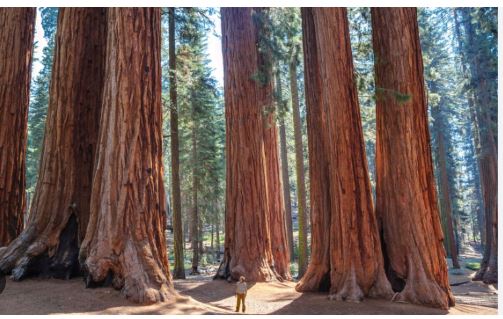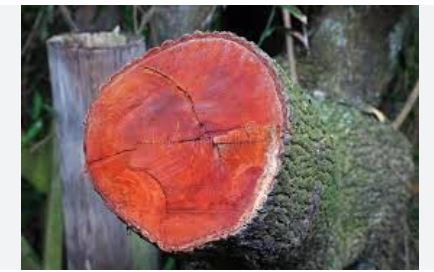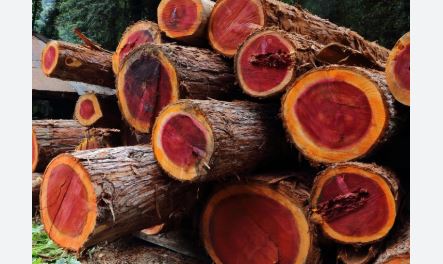
Trees with red wood are valued for their heartwood, which displays vibrant shades from bright red to deep reddish-brown, often due to natural pigments like tannins or other compounds. These trees, encompassing both hardwoods and some softwoods, are sought after in woodworking for crafting furniture, cabinetry, carvings, and decorative items due to their rich color and often durable grain. Whether evergreen or deciduous, their wood provides both aesthetic appeal and functional strength, making them prized for both practical and ornamental uses. In landscapes, they stand out as bold additions, offering shade or serving as striking focal points.

These trees thrive across a range of climates, from tropical to temperate, with many requiring full sun to enhance the intensity of their wood’s coloration and promote healthy growth. Well-drained soil is essential to avoid root problems, and some are adaptable to dry or poor soils, suiting diverse environments. They vary from compact, ornamental sizes to towering specimens, accommodating small gardens or large estates. Choosing varieties suited to local conditions ensures vibrant wood and robust growth with minimal maintenance.
In garden design, these trees can function as statement pieces, privacy screens, or shade providers, with their wood adding value if harvested for crafting. Smaller types fit well in urban settings or as accents, while larger ones are ideal for expansive landscapes or ecological restoration. Light pruning helps maintain their structure, but over-cutting should be avoided to preserve health. Pairing them with contrasting foliage or textures creates visually dynamic landscapes year-round.
The red wood, often deepening with age, benefits from UV-protective finishes in woodworking to retain its vivid hue, as exposure can darken it over time. Some species offer additional traits like pest resistance or aromatic qualities, enhancing their utility for outdoor structures or specialty items. Their combination of beauty and strength makes them versatile for both landscaping and artisanal projects, contributing to sustainable garden and craft practices.

Types of Trees With Red Wood
Coast Redwood (Sequoia sempervirens)
- Description: A towering evergreen conifer with soft, reddish-brown heartwood, known for its durability and rot resistance. The wood’s color comes from high tannin content.
- Uses: Lumber for furniture, decking, and exterior siding due to its weather resistance.
- Care Tips: Full sun, moist, well-drained soil. Hardy in USDA zones 7-9. Thrives in coastal climates with fog.
- Garden Appeal: Massive size (up to 380 feet tall) makes it a dramatic landscape feature, though often impractical for small gardens.
Giant Sequoia (Sequoiadendron giganteum)
- Description: An evergreen conifer with reddish-brown heartwood similar to coast redwood, prized for its strength and longevity.
- Uses: Used historically for construction and fencing; now primarily ornamental due to conservation concerns.
- Care Tips: Full sun, well-drained soil, higher elevations (5,000-7,000 feet). Hardy in zones 6-8.
- Garden Appeal: Massive (up to 311 feet tall), ideal for large estates or parks, with a stout, reddish trunk.
Redheart (Erythroxylon havanense)
- Description: A Central American hardwood with vibrant, watermelon-red heartwood that darkens to deep red over time.
- Uses: Ideal for turning, small decorative items, and accents due to its bright color and tight grain.
- Care Tips: Full sun, well-drained soil. Hardy in zones 9-11, suited for tropical climates.
- Garden Appeal: Smaller tree (20-30 feet), suitable for warm-region gardens with a striking wood color.
Chakte Kok (Simira salvadorensis)
- Description: A Central American hardwood with bright red to reddish-orange heartwood, often confused with Redheart due to similar appearance.
- Uses: Used for furniture, carvings, and musical instruments for its vivid color and workability.
- Care Tips: Full sun, well-drained soil. Hardy in zones 10-11, tropical environments.
- Garden Appeal: Moderate size (20-40 feet), adds exotic flair to warm-climate landscapes.
Bloodwood (Brosimum paraense)
- Description: A South American hardwood with deep, strawberry-red heartwood and golden streaks, darkening to reddish-brown with age.
- Uses: High-luster wood for furniture, turnings, and decorative accents; requires sharp tools.
- Care Tips: Full sun, moist, well-drained soil. Hardy in zones 10-12.
- Garden Appeal: Medium-sized tree (30-50 feet), striking for tropical gardens.
Padauk (Pterocarpus soyauxii)
- Description: An African hardwood with bright red-orange heartwood that matures to a deep brown-red, known for its durability.
- Uses: Furniture, cabinetry, and veneer; its color is prized for decorative woodworking.
- Care Tips: Full sun, well-drained soil. Hardy in zones 10-11, tropical climates.
- Garden Appeal: Grows to 60-100 feet, offering shade and bold wood for large landscapes.
Red Cedar (Toona ciliata)
- Description: An Australian hardwood with reddish-brown heartwood, aromatic and rot-resistant, softer than other cedars.
- Uses: Furniture, doors, and interior cladding; valued for its rich color and straight grain.
- Care Tips: Full sun, fertile, well-drained soil. Hardy in zones 9-11.
- Garden Appeal: Tall (up to 100 feet), suitable for large gardens with a tropical aesthetic.
Red Oak (Quercus rubra)
- Description: A North American hardwood with pale reddish-brown heartwood, known for its strength and grain pattern.
- Uses: Flooring, cabinetry, and furniture; widely used in interior joinery and veneer.
- Care Tips: Full sun, well-drained soil. Hardy in zones 3-7.
- Garden Appeal: Grows to 60-80 feet, providing shade and fall foliage (though wood remains red).
Cherry (Prunus serotina)
- Description: A North American hardwood with rich, reddish-brown heartwood that deepens with age, prized for its smooth texture.
- Uses: High-end furniture, cabinetry, and musical instruments; valued for its warm color.
- Care Tips: Full sun to partial shade, well-drained soil. Hardy in zones 3-9.
- Garden Appeal: Medium-sized (50-80 feet), with attractive spring blossoms and red wood.
Sapele (Entandrophragma cylindricum)
- Description: An African hardwood with reddish-brown heartwood, often with a figured grain, resembling mahogany.
- Uses: Furniture, musical instruments, and veneer; prized for its durability and color.
- Care Tips: Full sun, well-drained soil. Hardy in zones 10-12, tropical climates.
- Garden Appeal: Tall (up to 150 feet), suitable for large tropical landscapes.
Bubinga (Guibourtia demeusei)
- Description: An African hardwood with deep red to reddish-brown heartwood, often with striking figuring.
- Uses: Luxury furniture, turnings, and decorative inlays; valued for its density and color.
- Care Tips: Full sun, moist, well-drained soil. Hardy in zones 10-11.
- Garden Appeal: Grows to 80-130 feet, ideal for expansive, warm-climate gardens.
Spanish Cedar (Cedrela odorata)
- Description: A Central American hardwood with reddish-brown, aromatic heartwood, resistant to pests.
- Uses: Cigar boxes, musical instruments, and furniture; valued for its scent and color.
- Care Tips: Full sun, well-drained soil. Hardy in zones 9-11.
- Garden Appeal: Medium to tall (50-100 feet), adds tropical elegance to landscapes.
Red Mahogany (Eucalyptus resinifera)
- Description: An evergreen hardwood with deep reddish-brown heartwood, known for its strength and fine grain.
- Uses: Furniture, flooring, and boatbuilding due to its durability and rich color.
- Care Tips: Full sun, well-drained soil. Hardy in USDA zones 9-11, prefers warm climates.
- Garden Appeal: Tall (up to 100 feet), ideal for large landscapes or shade in warm regions.
- Size: 60-100 feet tall.
Cocobolo (Dalbergia retusa)
- Description: A tropical hardwood with vibrant red to reddish-orange heartwood, often streaked with black, highly prized for its density.
- Uses: Luxury items like knife handles, musical instruments, and turnings due to its lustrous finish.
- Care Tips: Full sun, well-drained soil. Hardy in zones 10-12, tropical climates.
- Garden Appeal: Small to medium (20-50 feet), adds exotic flair to warm-climate gardens.
Red Sandalwood (Pterocarpus santalinus)
- Description: A hardwood with rich, deep red heartwood, valued for its intense color and fragrance.
- Uses: Dyes, furniture, and carvings; culturally significant in some regions.
- Care Tips: Full sun, well-drained, sandy soil. Hardy in zones 10-11, slow-growing.
- Garden Appeal: Medium-sized (20-40 feet), suitable for ornamental tropical gardens.
Red Maple (Acer rubrum)
- Description: A deciduous hardwood with pale reddish heartwood, less vibrant but still notable for its warm tones.
- Uses: Furniture, cabinetry, and veneer; valued for its workability and grain.
- Care Tips: Full sun to partial shade, moist, well-drained soil. Hardy in zones 3-9.
- Garden Appeal: Grows to 40-70 feet, with attractive fall foliage complementing its red wood.
Rosewood (Dalbergia spp., e.g., Dalbergia nigra)
- Description: A tropical hardwood with dark reddish-brown heartwood, often with black streaks, known for its rich color.
- Uses: High-end furniture, musical instruments, and decorative inlays.
- Care Tips: Full sun, well-drained soil. Hardy in zones 10-12, tropical climates.
- Garden Appeal: Medium to tall (30-60 feet), striking for large, warm-climate landscapes.
Red Ironbark (Eucalyptus sideroxylon)
- Description: An evergreen hardwood with reddish-brown heartwood, extremely dense and durable.
- Uses: Heavy construction, railway sleepers, and outdoor furniture due to its strength.
- Care Tips: Full sun, well-drained soil, drought-tolerant. Hardy in zones 9-11.
- Garden Appeal: Grows to 50-100 feet, ideal for shade or windbreaks in dry regions.
Red Alder (Alnus rubra)
- Description: A hardwood with light reddish-brown heartwood, softer than other red woods but valued for its color.
- Uses: Furniture, cabinetry, and veneer; often used for rustic designs.
- Care Tips: Full sun to partial shade, moist soil. Hardy in zones 3-7.
- Garden Appeal: Medium-sized (40-80 feet), thrives in wetter soils for naturalistic landscapes.
Jatoba (Hymenaea courbaril)
- Description: A tropical hardwood with deep reddish-brown heartwood, known for its hardness and durability.
- Uses: Flooring, furniture, and tool handles; prized for its rich color and strength.
- Care Tips: Full sun, well-drained soil. Hardy in zones 10-12, tropical climates.
- Garden Appeal: Large (50-100 feet), provides shade and bold wood for tropical gardens.
Red Gum (Eucalyptus camaldulensis)
- Description: An evergreen hardwood with reddish-brown heartwood, valued for its toughness and versatility.
- Uses: Furniture, firewood, and construction; popular for outdoor applications.
- Care Tips: Full sun, well-drained soil, highly drought-tolerant. Hardy in zones 9-11.
- Garden Appeal: Tall (60-150 feet), ideal for large landscapes or erosion control.
Red Meranti (Shorea spp.)
- Description: A tropical hardwood with reddish-brown heartwood, lighter than other red woods but durable.
- Uses: Construction, furniture, and plywood; valued for its consistent color.
- Care Tips: Full sun, moist, well-drained soil. Hardy in zones 10-12.
- Garden Appeal: Very tall (100-200 feet), suited for expansive tropical landscapes.
Red Balau (Shorea guiso)
- Description: A tropical hardwood with deep red-brown heartwood, known for its resistance to weathering.
- Uses: Decking, outdoor furniture, and marine construction due to its durability.
- Care Tips: Full sun, well-drained soil. Hardy in zones 10-11.
- Garden Appeal: Large (80-120 feet), adds stately presence to warm-climate gardens.
Red Ebony (Diospyros crassiflora)
- Description: A tropical hardwood with dark reddish-black heartwood, rare and highly valued.
- Uses: Luxury furniture, carvings, and musical instruments due to its density and color.
- Care Tips: Full sun, well-drained soil. Hardy in zones 10-12, slow-growing.
- Garden Appeal: Medium-sized (30-50 feet), exotic for ornamental tropical gardens.
Red Mulberry (Morus rubra)
- Description: A deciduous hardwood with reddish-brown heartwood, valued for its strength and warm tones.
- Uses: Furniture, fences, and small crafts; less common but appreciated for color.
- Care Tips: Full sun, well-drained soil. Hardy in zones 4-8.
- Garden Appeal: Medium-sized (30-50 feet), with edible fruit and attractive wood.
Tips for Growing Trees with Red Wood
- Climate Matching: Select trees suited to your climate; tropical species like bloodwood or padauk thrive in warm regions, while red oak and cherry suit cooler zones.
- Sunlight: Most require full sun to enhance wood color and growth; ensure adequate spacing for large species like redwoods.
- Soil: Well-drained soil is critical; some, like red cedar, tolerate poorer soils but benefit from fertility.
- Uses in Landscaping: Smaller trees (e.g., Redheart) suit ornamental gardens; larger ones (e.g., redwoods, sapele) are better for estates or reforestation.
- Woodworking Note: Protect red wood’s vibrant color with UV-inhibiting finishes, as many darken with exposure.